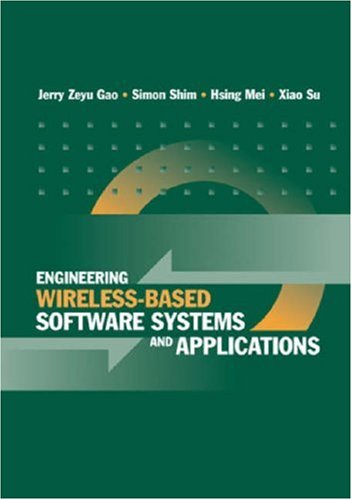買這商品的人也買了...
-
 Java and XML Data Binding
Java and XML Data Binding$1,360$1,292 -
 The Rational Unified Process Made Easy: A Practitioner's Guide to RUP (Paperback)
The Rational Unified Process Made Easy: A Practitioner's Guide to RUP (Paperback)$2,270$2,157 -
 C# 學習經典 (Learn to Program with C#)
C# 學習經典 (Learn to Program with C#)$550$468 -
 Flash MX 商務網站建置範本
Flash MX 商務網站建置範本$580$493 -
 CCNA Self-Study: Interconnecting Cisco Network Devices (ICND) 640-811, 640-801, 2/e
CCNA Self-Study: Interconnecting Cisco Network Devices (ICND) 640-811, 640-801, 2/e$2,270$2,157 -
 Struts: The Complete Reference
Struts: The Complete Reference$1,840$1,748 -
 The Linux Networking Architecture: Design and Implementation of Network Protocols in the Linux Kernel (Paperback)
The Linux Networking Architecture: Design and Implementation of Network Protocols in the Linux Kernel (Paperback)$2,920$2,774 -
 Reporting Service 實戰演練
Reporting Service 實戰演練$690$587 -
 Excel 2003 VBA 實例演練
Excel 2003 VBA 實例演練$480$408 -
 如何設計組合語言程式, 2/e
如何設計組合語言程式, 2/e$149$149 -
 Perl 學習手札
Perl 學習手札$390$332 -
 PHP 5 與 MySQL 4 入門學習指南
PHP 5 與 MySQL 4 入門學習指南$550$468 -
 Head First Servlets & JSP
Head First Servlets & JSP$1,980$1,881 -
 Internet TCP/IP 協定觀念與實作, 2/e
Internet TCP/IP 協定觀念與實作, 2/e$580$493 -
 Java 2 入門與實務應用
Java 2 入門與實務應用$580$458 -
 VB .NET 程式設計藝術 (Visual Basic .NET How to Program, 2/e)
VB .NET 程式設計藝術 (Visual Basic .NET How to Program, 2/e)$850$765 -
 UML For Java Proframmers 中文版:靈活運用 UML 開發 Java 程式 (UML For Java Programmers)
UML For Java Proframmers 中文版:靈活運用 UML 開發 Java 程式 (UML For Java Programmers)$460$363 -
 ISA Server 2004 防火牆安裝與管理指南
ISA Server 2004 防火牆安裝與管理指南$640$506 -
 PC 秀逗事件簿─馬上解決 100 個電腦使用問題
PC 秀逗事件簿─馬上解決 100 個電腦使用問題$360$306 -
 Head First Design Patterns (Paperback)
Head First Design Patterns (Paperback)$2,420$2,299 -
 $1,080Windows System Programming, 3/e (Hardcover)
$1,080Windows System Programming, 3/e (Hardcover) -
 Microsoft Windows 802.11 無線網路保安秘訣徹底研究 (Deploying Secure 802.11 Wireless Networks with Microsoft Windows)
Microsoft Windows 802.11 無線網路保安秘訣徹底研究 (Deploying Secure 802.11 Wireless Networks with Microsoft Windows)$490$387 -
 PHP 網頁模組隨學隨用
PHP 網頁模組隨學隨用$480$408 -
 Red Hat Enterprise Linux 管理指南
Red Hat Enterprise Linux 管理指南$580$493 -
 ASP.NET 徹底研究進階技巧─高階技巧與控制項實作
ASP.NET 徹底研究進階技巧─高階技巧與控制項實作$650$507
相關主題
商品描述
Description:
The use of parallel processing technology in the next generation of Database Management Systems (DBMSs) makes it possible to meet new and challenging requirements. Database technology in rapidly expanding new application areas brings unique challenges such as increased functionality and efficient handling of very large heterogeneous databases.
Abdelguerfi and Wong present the latest techniques in parallel relational databases illustrating high-performance achievements in parallel database systems. The text is structured according to the overall architecture of a parallel database system presenting various techniques that may be adopted to the design of parallel database software and hardware execution environments. These techniques can directly or indirectly lead to high-performance parallel database implementation.
The book's main focus follows the authors' engineering model: A survey of parallel query optimization techniques for requests involving multi-way joins; A new technique for a join operation that can be adopted in the local optimization stage; A framework for recovery in parallel database systems using the ACTA formalism; The architectural details of NCR's new Petabyte multimedia database system; A description of the Super Database Computer (SDC-II); A case study for a shared-nothing parallel database server that analyzes and compares the effectiveness of five data placement techniques.
Table of Contents:
1 Introduction.
1.1 Background.
1.2 Parallel Database Systems.
1.2.1 Computation Model.
1.2.2 Engineering Model.
1.3 About this Manuscript.
Bibliography.
I: Request Manager.
2 Designing an Optimizer for Parallel Relational Systems.
2.1 Introduction.
2.2 Overall Design Issues.
2.2.1 Design a Simple Parallel Execution Model.
2.2.2 The Two-Phase Approach.
2.2.3 Parallelizing is Adding Information!
2.2.4 Two-Phase versus Parallel Approaches.
2.3 Parallelization.
2.3.1 Kinds of Parallelism.
2.3.2 Specifying Parallel Execution.
2.4 Search Space.
2.4.1 Slicing Hash Join Trees.
2.4.2 Search Space Size.
2.4.3 Heuristics.
2.4.4 The Two-Phase Heuristics.
2.5 Cost Model.
2.5.1 Exceptions to the Principle of Optimality.
2.5.2 Resources.
2.5.3 Skew and Size Model.
2.5.4 The Cost Function.
2.6 Search Strategies.
2.6.1 Deterministic Search Strategies.
2.6.2 Randomized Strategies.
2.7 Conclusion.
Bibliography.
3 New Approaches to Parallel Join Utilizing Page Connectivity Information.
3.1 Introduction.
3.2 The Environment and a Motivating Example.
3.3 The Methodology.
3.3.1 Definition of Parameters.
3.3.2 The Balancing Algorithm.
3.3.3 Schedules for Reading Join Components and Data Pages.
3.4 Performance Analysis.
3.4.1 The Evaluation Method.
3.4.2 Evaluation Results.
3.5 Concluding Remarks and Future Work.
Bibliography.
4 A Performance Evaluation Tool for Parallel Database Systems.
4.1 Introduction.
4.2 Performance Evaluation Methods.
4.2.1 Analytical Modeling.
4.2.2 Benchmarks.
4.2.3 Observations.
4.3 The Software Testpilot.
4.3.1 The Experiment Specification.
4.3.2 The Performance Assessment Cycle.
4.3.3 The System Interface.
4.4 The Software Testpilot and Oracle/Ncube.
4.4.1 Database System Performance Assessment.
4.4.2 The Oracle/Ncube Interface.
4.5 Preliminary Results.
4.6 Conclusion.
Bibliography.
5 Load Placement in Distributed High-Performance Database Systems.
5.1 Introduction.
5.2 Investigated System.
5.2.1 System Architecture.
5.2.2 Load Scenarios.
5.2.3 Trace Analysis.
5.2.4 Load Setup.
5.3 Load Placement Strategies Investigated.
5.4 Scheduling Strategies for Transactions.
5.5 Simulation Results.
5.5.1 Influence of Scheduling.
5.5.2 Evaluation of the Load Placement Strategies.
5.5.3 Lessons Learned.
5.5.4 Decision Parameters Used.
5.6 Conclusion and Open Issues.
Bibliography.
II: Parallel Machine Architecture.
6 Modeling Recovery in Client-Server Database Systems.
6.1 Introduction.
6.2 Uniprocessor Recovery and Formal.
Approach to Modeling Recovery.
6.2.1 Basic Formal Concepts.
6.2.2 Logging Mechanisms.
6.2.3 Runtime Policies for Ensuring Correctness.
6.2.4 Data Structures Maintained for Efficient Recovery.
6.2.5 Restart Recovery--The ARIES Approach.
6.3 LSN Sequencing Techniques for Multinode Systems.
6.4 Recovery in Client-Server Database Systems.
6.4.1 Client-Server EXODUS (ESM-CS).
6.4.2 Client-Server ARIES (ARIES/CSA).
6.4.3 Shared Nothing Clients with Disks (CD).
6.4.4 Summary of Recovery Approaches in Client-Server Architectures.
6.5 Conclusion.
Bibliography.
7 Parallel Strategies for a Petabyte Multimedia Database Computer.
7.1 Introduction.
7.2 Multimedia Data Warehouse, Databases, and Applications.
7.2.1 Three Waves of Multimedia Database Development.
7.2.2 National Medical Practice Knowledge Bank Application.
7.3 Massively Parallel Architecture, Infrastructure, and Technology.
7.3.1 Parallelism.
7.4 Teradata-MM Architecture, Framework, and New Concepts.
7.4.1 Teradata-MM Architecture.
7.4.2 Key New Concepts.
7.4.3 SQL3.
7.4.4 Federated Coordinator.
7.4.5 Teradata Multimedia Object Server.
7.5 Parallel UDF Execution Analysis.
7.5.1 UDF Optimizations.
7.5.2 PRAGMA Facility.
7.5.3 UDF Value Persistence Facility.
7.5.4 Spatial Indices for Content-Based Querying.
7.6 Conclusion.
Bibliography.
8 The MEDUSA Project.
8.1 Introduction.
8.2 Indexing and Data Partitioning.
8.2.1 Standard Systems.
8.2.2 Grid Files.
8.3 Dynamic Load Balancing.
8.3.1 Data Access Frequency.
8.3.2 Data Distribution.
8.3.3 Query Partitioning.
8.4 The MEDUSA Project.
8.4.1 The MEDUSA Architecture.
8.4.2 Software.
8.4.3 Grid File Implementation.
8.4.4 Load Balancing Strategy.
8.5 MEDUSA Performance Results.
8.5.1 Test Configuration.
8.5.2 Transaction Throughput.
8.5.3 Speedup.
8.5.4 Load Balancing Test Results.
8.6 Conclusions.
Bibliography.
III: Partitioned Data Store.
9 System Software of the Super Database Computer SDC-II.
9.1 Introduction.
9.2 Architectural Overview of the SDC-II.
9.3 Design and Organization of the SDC-II System Software.
9.3.1 Parallel Execution Model.
9.3.2 I/O Model and Buffer Management Strategy for Bulk Data Transfer.
9.3.3 Process Model and Efficient Flow Control Mechanism.
9.3.4 Structure of the System Software Components.
9.4 Evaluation of the SDC-II System.
9.4.1 Details of a Sample Query Processing.
9.4.2 Comparison with Commercial Systems.
9.5 Conclusion.
Bibliography.
10 Data Placement in Parallel Database Systems.
10.1 Introduction.
10.2 Overview of Data Placement Strategies.
10.2.1 Declustering and Redistribution.
10.2.2 Placement.
10.3 Effects of Data Placement.
10.3.1 STEADY and TPC-C.
10.3.2 Dependence on Number of Processing Elements.
10.3.3 Dependence on Database Size.
10.4 Conclusions.
Bibliography.
Contributors.
商品描述(中文翻譯)
**描述:**
在下一代資料庫管理系統(DBMS)中使用平行處理技術,使得滿足新的挑戰性需求成為可能。資料庫技術在快速擴展的新應用領域中帶來了獨特的挑戰,例如增加功能性和有效處理非常大的異構資料庫。
Abdelguerfi 和 Wong 提出了平行關聯資料庫中的最新技術,展示了平行資料庫系統中的高效能成就。該文本根據平行資料庫系統的整體架構進行結構化,介紹了可採用於平行資料庫軟體和硬體執行環境設計的各種技術。這些技術可以直接或間接導致高效能的平行資料庫實作。
本書的主要焦點遵循作者的工程模型:對涉及多路連接的請求的平行查詢優化技術進行調查;一種可在本地優化階段採用的連接操作新技術;使用 ACTA 形式主義的平行資料庫系統恢復框架;NCR 新的 Petabyte 多媒體資料庫系統的架構細節;超資料庫計算機(SDC-II)的描述;一個共享無物件平行資料庫伺服器的案例研究,分析和比較五種資料放置技術的有效性。
**目錄:**
1 介紹。
1.1 背景。
1.2 平行資料庫系統。
1.2.1 計算模型。
1.2.2 工程模型。
1.3 關於本手稿。
參考文獻。
I:請求管理器。
2 為平行關聯系統設計優化器。
2.1 介紹。
2.2 整體設計問題。
2.2.1 設計簡單的平行執行模型。
2.2.2 雙階段方法。
2.2.3 平行化即是增加資訊!
2.2.4 雙階段與平行方法的比較。
2.3 平行化。
2.3.1 平行性種類。
2.3.2 指定平行執行。
2.4 搜索空間。
2.4.1 切片哈希連接樹。
2.4.2 搜索空間大小。
2.4.3 啟發式。
2.4.4 雙階段啟發式。
2.5 成本模型。
2.5.1 最優性原則的例外情況。
2.5.2 資源。
2.5.3 偏斜和大小模型。
2.5.4 成本函數。
2.6 搜索策略。
2.6.1 確定性搜索策略。
2.6.2 隨機化策略。
2.7 結論。
參考文獻。
3 利用頁面連接資訊的平行連接新方法。
3.1 介紹。
3.2 環境和激勵示例。
3.3 方法論。
3.3.1 參數定義。
3.3.2 平衡算法。
3.3.3 讀取連接組件和資料頁的排程。
3.4 性能分析。
3.4.1 評估方法。
3.4.2 評估結果。
3.5 結論性評論和未來工作。
參考文獻。
4 平行資料庫系統的性能評估工具。
4.1 介紹。
4.2 性能評估方法。
4.2.1 分析建模。
4.2.2 基準測試。
4.2.3 觀察。
4.3 軟體測試飛行員。
4.3.1 實驗規範。
4.3.2 性能評估週期。
4.3.3 系統介面。
4.4 軟體測試飛行員與 Oracle/Ncube。
4.4.1 資料庫系統性能評估。
4.4.2 Oracle/Ncube 介面。
4.5 初步結果。
4.6 結論。
參考文獻。
5 在分散式高效能資料庫系統中的負載放置。
5.1 介紹。
5.2 研究系統。
5.2.1 系統架構。
5.2.2 負載場景。
5.2.3 跟蹤分析。
5.2.4 負載設置。
5.3 研究的負載放置策略。
5.4 交易的排程策略。
5.5 模擬結果。
5.5.1 排程的影響。
5.5.2 負載放置策略的評估。
5.5.3 獲得的經驗教訓。
5.5.4 使用的決策參數。
5.6 結論和未解決問題。
參考文獻。
II:平行機器架構。
6 在客戶端-伺服器資料庫系統中建模恢復。
6.1 介紹。
6.2 單處理器恢復和正式。
建模恢復的方法。
6.2.1 基本正式概念。
6.2.2 日誌機制。
6.2.3 確保正確性的運行時策略。
6.2.4 為有效恢復維護的資料結構。
6.2.5 重啟恢復——ARIES 方法。
6.3 多節點系統的 LSN 排序技術。
6.4 客戶端-伺服器資料庫系統中的恢復。
6.4.1 客戶端-伺服器 EXODUS (ESM-CS)。
6.4.2 客戶端-伺服器 ARIES (ARIES/CSA)。
6.4.3 共享無物件的客戶端與磁碟 (CD)。
6.4.4 客戶端-伺服器架構中恢復方法的總結。
6.5 結論。
參考文獻。
7 平行策略用於 Petabyte 多媒體資料庫計算機。
7.1 介紹。
7.2 多媒體資料倉庫、資料庫和應用。
7.2.1 多媒體資料庫發展的三波浪潮。
7.2.2 國家醫療實踐知識庫應用。
7.3 大規模平行架構、基礎設施和技術。
7.3.1 平行性。
7.4 Teradata-MM 架構、框架和新概念。
7.4.1 Teradata-MM 架構。
7.4.2 主要新概念。
7.4.3 SQL3。
7.4.4 聯邦協調器。
7.4.5 Teradata 多媒體物件伺服器。
7.5 平行 UDF 執行分析。
7.5.1 UDF 優化。
7.5.2 PRAGMA 功能。
7.5.3 UDF 值持久性功能。
7.5.4 用於基於內容查詢的空間索引。
7.6 結論。
參考文獻。
8 MEDUSA 專案。
8.1 介紹。
8.2 索引和資料分區。
8.2.1 標準系統。
8.2.2 網格檔案。
8.3 動態負載平衡。
8.3.1 資料存取頻率。
8.3.2 資料分佈。
8.3.3 查詢分區。
8.4 MEDUSA 專案。
8.4.1 MEDUSA 架構。
8.4.2 軟體。
8.4.3 網格檔案實作。
8.4.4 負載平衡策略。
8.5 MEDUSA 性能結果。
8.5.1 測試配置。
8.5.2 交易吞吐量。
8.5.3 加速。
8.5.4 負載平衡測試結果。
8.6 結論。































